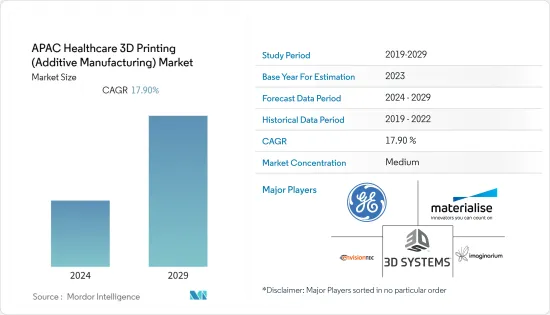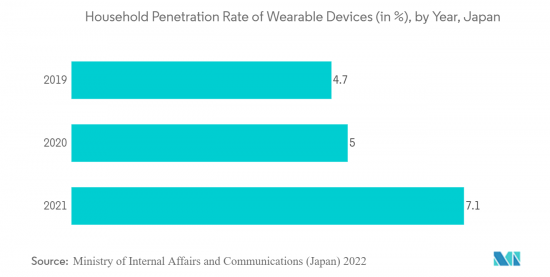PUBLISHER: Mordor Intelligence | PRODUCT CODE: 1403034

PUBLISHER: Mordor Intelligence | PRODUCT CODE: 1403034
APAC Healthcare 3D Printing (Additive Manufacturing) - Market Share Analysis, Industry Trends & Statistics, Growth Forecasts 2024 - 2029

The Asia-Pacific Healthcare 3D Printing (Additive Manufacturing) Market is valued at USD 0.56 billion and is expected to reach USD 1.29 billion by the year 2028, registering a CAGR of 17.9% over the forecast period.
The COVID-19 pandemic had a significant impact on the market studied. According to the National Institute of Health study published in 2020, 3D printing was used extensively during the pandemic and was being utilized to produce vital medical supplies during the crisis. Some vital goods, including ventilator valves, face shields, swabs, oxygen valves, hand sanitizer holders, 3-D lung models, etc., were manufactured via 3D printing during the pandemic. The capacity of 3D printing to print locally using digital designs and reduce supply chain factors has been the key reason for its success. Furthermore, PubMed data published in November 2021 stated that the ability of 3D printing to manufacture/print complicated geometrical patterns locally was the primary reason for its widespread adoption during COVID-19. Therefore, it was observed that the pandemic positively impacted the market studied. However, the market has reached its pre-pandemic nature regarding demand for 3D printing and is expected to witness strong growth in the coming years.
Key factors responsible for the market growth include increasing demand for customized 3D printed parts and instruments and patent expiration. There has been an increase in the demand for customized additive manufacturing as customized structures are more comfortable for patients. For instance, in November 2021, the Australian Government expanded a world-class 3D medical manufacturing facility in Port Melbourne. Minister for Innovation, Medical Research, and the Digital Economy stated that the new investment will enable Melbourne-based 3DMEDiTech to transform its existing facility, supercharging Victoria's advanced medical manufacturing sector and reducing wait times for Victorians needing implants. Hence, with such demand for 3D printing, the market studied is expected to grow strongly in the coming years.
Additionally, data from the Journal of Controlled Release published in February 2021 stated that precision medicine has rapidly overtaken conventional medicine over the past few years. 3D printing, particularly Fused Deposition Modeling (FDM), has been proven to be a potential method for customizing oral medicine administration. The data further stated that additive manufacturing, often known as 3D printing technology, is expected to change how drugs are produced in the coming years. Hence, with the increasing use of 3D printing technology, the market studied is expected to grow significantly over the forecast period.
When patents on 3D printing technologies or specific medical devices expire, other companies can enter the market and manufacture similar products. This increased competition often leads to lower prices for 3D printers, materials, and medical devices, making them more accessible to healthcare providers and driving cost reduction in the industry.
However, additive manufacturing costs are still high, leading to affordability issues, especially in developing and underdeveloped countries. Also, there is a lack of skilled professionals to operate these machinery. These factors have impeded market growth.
APAC Healthcare 3D Printing Market Trends
Wearable Devices Segment in Applications is Expected to Witness a Significant Growth in Coming Years
The next-generation tools for numerous healthcare applications are now considered wearable devices powered by developing 3D printing technology. In addition, a variety of 3D printed (bio)sensing platforms is available, including wearable oximeters, smart bandages, artificial skin, tattoo sensors, glucose sensors, lactate sensors, sweat sensors, strain sensors, tactile sensors, electroencephalography (EEG), electrocardiography (ECG), and others.
New launches of wearable devices in Asian countries are due to the increasing demand for the same. To provide innovative technologies, 3D printing is on the rise. For instance, in March 2022, Amrita University, a private university in India, launched a wearable health monitoring device. Amrita Spandanam is a wearable device that uses a finger clip to measure six body parameters: blood glucose, blood pressure, heart rate, blood oxygen, respiratory rate, and 6-lead ECG. Moreover, the wearable device integrates multiple learning models to predict the potential deterioration of a user's health.
Furthermore, in August 2022, SmartCardia launched the 7L patch, their 7-lead cardiac monitoring patch in India. This state-of-the-art patch monitor combines medical wearable technology with artificial intelligence (AI) to provide predictive and personalized patient insights through remote monitoring. Such product launches provide portable patient monitoring with the help of sensors embedded into them. Such product launches in the market are expected to boost the wearable devices segment in the coming future.

Japan is Expected to Witness a Strong Growth in Coming Years
Japan is one of the most advanced countries in terms of technological innovations. Regarding the 3D printing market, Japanese tissue engineering specialists believe that 3-D printing technology will help regenerative medicine advance because it can economically produce human tissue.
Wearable sensor technology is largely growing in Japan, fueling the market growth. For instance, in October 2022, Biocorp, a French company specializing in designing, developing, and manufacturing innovative medical devices, announced a partnership agreement with Novo Nordisk to commercialize Mallya, initially in Japan. Mallya is a smart sensor that directly attaches to the Novo Nordisk FlexTouch insulin pens and can monitor blood glucose. With such key developments from the companies, it is believed that 3D printing technology will be increasing in the coming years across Japan.
Furthermore, in July 2021, Terumo Corporation launched Japan's Dexcom G6 continuous glucose monitoring system. Dexcom, Inc., based in the United States, manufactures the product, and Terumo holds the exclusive distribution agreement in Japan. The device includes a wearable monitoring sensor. Such developments are likely to bolster the market's growth studied in the forecast period.
TCT Japan (Formerly 3D Printing Japan) is a significant additive manufacturing and 3D printing event that attracts specialists from the industry to Tokyo to discuss the difficulties of implementing new technologies into the Japanese manufacturing business. Hence, with such events, people across the country are becoming more educated about 3D printing technology, which is surging the market growth.
APAC Healthcare 3D Printing Industry Overview
Most of the countries in Asia-Pacific are developing countries. These developing economies have a high number of people with unattended physical disabilities, which 3D printed instruments could improve. As a result, these countries are highly lucrative for global players to enter the market. Hence, this region enjoys the presence of most of the global players in the Healthcare 3D Printing market. Moreover, some regional players have also established their presence in the region.
Additional Benefits:
- The market estimate (ME) sheet in Excel format
- 3 months of analyst support
TABLE OF CONTENTS
1 INTRODUCTION
- 1.1 Study Assumptions and Market Definition
- 1.2 Scope of the Study
2 RESEARCH METHODOLOGY
3 EXECUTIVE SUMMARY
4 MARKET DYNAMICS
- 4.1 Market Overview
- 4.2 Market Drivers
- 4.2.1 Demand For Customized 3D Printed Parts and Instruments
- 4.2.2 Patent Expiration
- 4.3 Market Restraints
- 4.3.1 High costs associated with 3D Printing
- 4.3.2 Lack of Skilled Professionals
- 4.4 Porter's Five Forces Analysis
- 4.4.1 Bargaining Power of Buyers/Consumers
- 4.4.2 Bargaining Power of Suppliers
- 4.4.3 Threat of New Entrants
- 4.4.4 Threat of Substitute Products
- 4.4.5 Intensity of Competitive Rivalry
5 MARKET SEGMENTATION
- 5.1 By Technology
- 5.1.1 Stereolithography
- 5.1.2 Deposition Modeling
- 5.1.3 Electron Beam Melting
- 5.1.4 Laser Sintering
- 5.1.5 Jetting Technology
- 5.1.6 Laminated Object Manufacturing
- 5.1.7 Other Technologies
- 5.2 By Application
- 5.2.1 Medical Implants
- 5.2.2 Prosthetics
- 5.2.3 Wearable Devices
- 5.2.4 Other Applications
- 5.3 By Material
- 5.3.1 Metals and Alloys
- 5.3.2 Polymers
- 5.3.3 Other Materials
- 5.4 Geography
- 5.4.1 China
- 5.4.2 Japan
- 5.4.3 India
- 5.4.4 Australia
- 5.4.5 South Korea
- 5.4.6 Rest of Asia-Pacific
6 COMPETITIVE LANDSCAPE
- 6.1 Company Profiles
- 6.1.1 General Electric
- 6.1.2 3D Systems, Inc.
- 6.1.3 EnvisionTEC GMBH
- 6.1.4 Eos GmbH
- 6.1.5 Imaginarium
- 6.1.6 JGroup Robotics
- 6.1.7 Materialise N.V.
- 6.1.8 Stratasys LTD.
- 6.1.9 Nanoscribe GmbH
7 MARKET OPPORTUNITIES AND FUTURE TRENDS




